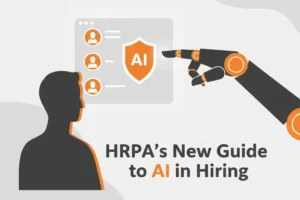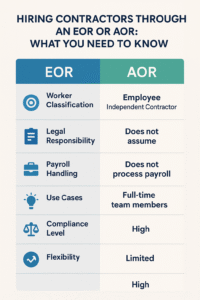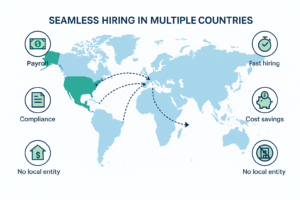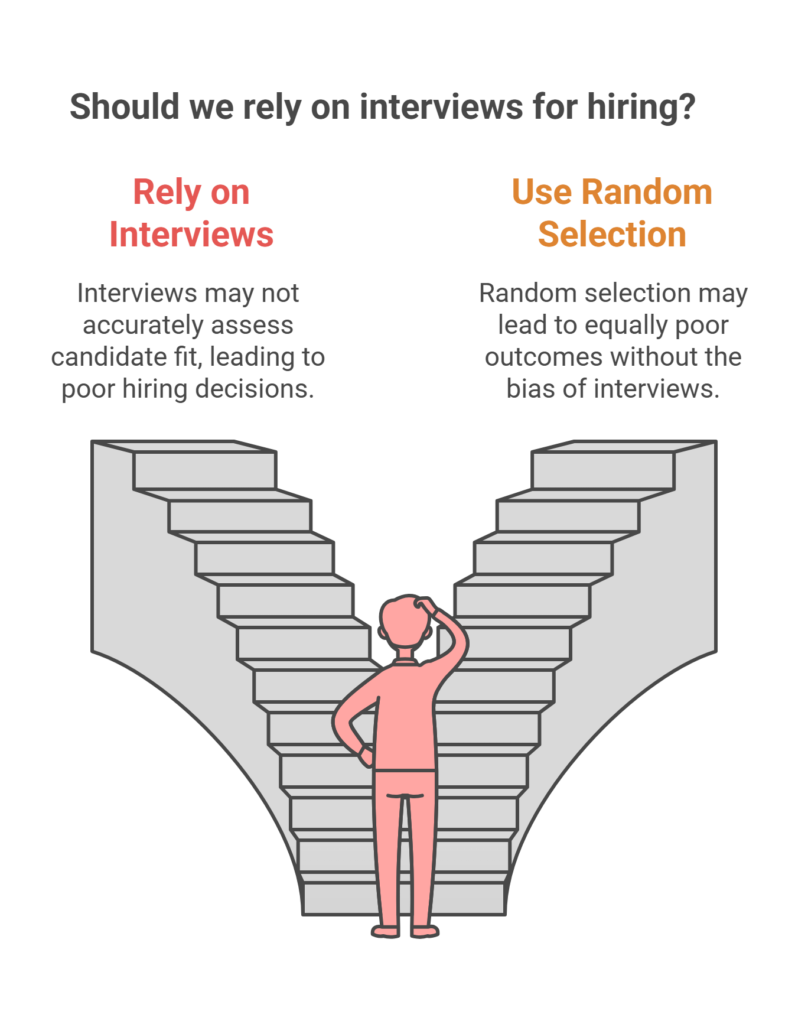
Interviews vs. Random Chance: What the Numbers Say
Have you ever felt like hiring the right person is like flipping a coin? You’re not alone. Mounting evidence shows that traditional unstructured interviews – the typical “tell me about yourself” chats – are barely better than random chance at identifying successful employees. In fact, psychologists have warned for years that many interview decisions are “no better than a coin flip.” One comprehensive study found that out of 100 hires made based on unstructured interviews, only about 8 hires turn out to be top performers Google’s own internal analysis of hiring was even more blunt: after examining tens of thousands of interviews, they found “zero relationship” between interview scores and job performance – calling the process “a complete random mess” . In other words, hiring managers might get it right only 20–50% of the time, which is essentially by chance.
Such dismal predictive power has real consequences. Industry studies estimate that almost half of new hires fail within 18 months . Think about that – after all the CV screening and interviews, managers are often making a 50/50 guess (or worse) on who will succeed. The U.S. Department of Labor estimates a “bad hire” costs 30% of that position’s first-year salary on average in wasted pay, benefits, and rehiring costs . For a $100,000 role, that’s a $30,000 mistake (some put the total cost even higher, up to $130,000 with severance and lost productivity). With odds like these, relying on an unstructured interview to select your next employee is essentially gambling with high stakes.
One famous anecdote drives the point home: In the late 1970s, a Texas medical school accidentally admitted 50 students it had initially rejected after interviews. Later analysis found those students performed just as well as the others in school and training . In other words, the interviewers’ judgments had added nothing of value – the rejected candidates were just as competent as those who “aced” the interviews. It’s a sobering reminder that our gut instincts in interviews are often unreliable. Research even shows interviewers usually can’t tell when candidates are giving random, scripted answers to questions . And consider this: most candidates prepare extensively (often with help from the internet and coaches) to deliver polished answers. Many will even stretch the truth – one survey noted 81% of people lie during job interviews . The result? Interviewers feel confident in their ability to “read” people, but in reality they’re frequently being duped by rehearsed performances or personal biases.
Why Traditional Interviews Fail to Predict Performance
Why are unstructured interviews so poor at predicting job success? The core issue is that a typical free-form interview is a tiny, artificial snapshot of a candidate – and not a very good one. It’s like trying to predict someone’s marriage compatibility from a single blind date. Human behavior is complex, and a half-hour chat full of generic questions (“What’s your greatest weakness?”) provides a minuscule sample of how someone will actually perform over months and years . Moreover, the traits that help someone impress in an interview (confidence, smooth talking, quick thinking) may have little to do with the actual job requirements. For example, extroverts typically shine in unstructured interviews, but extraversion isn’t what most jobs truly require for success . This lack of “ecological validity” means the interview setting doesn’t mirror real work situations, so it elicits behaviors that don’t reliably translate to on-the-job performance.
Compounding the problem, unstructured interviews are rife with bias and noise. Without a consistent structure, interviewers tend to make snap judgments and let irrelevant factors sway their decisions. A wealth of psychological research (pioneered by experts like Daniel Kahneman) shows that we’re all subject to subconscious biases. In interviews, these biases can badly distort evaluations.
- Halo/Horns effect – If a candidate impresses (or falters) on one aspect, the interviewer’s overall impression skews positive or negative accordingly . For instance, one awkward answer or a shared alma mater can color the entire interview outcome.
- Anchoring bias – Early impressions stick. If a candidate is nervous in the first five minutes, an interviewer might never shake that negative first impression .
- Affinity/Similarity bias – Interviewers often favor people who are similar to themselves in background, interests, or personality . This “just like me” bias can crowd out more qualified candidates who don’t fit the same mold.
- Confirmation bias – An interviewer might have a pet theory (“People from X company are all mediocre”) and will subconsciously seek evidence in the interview to confirm it . Tough luck for the candidate who unknowingly triggers that bias.
- Overconfidence – Perhaps most insidious, many interviewers overestimate their ability to judge character and talent . A hiring manager who trusts their gut (“I’m a good judge of people”) is less likely to recognize when their interview process is flawed.
These are just a few of the cognitive biases that plague unstructured interviews . Add in other factors – like inconsistent questions, varying interviewer skill, and candidates gaming the process – and it’s no surprise that traditional interviews are wildly unreliable. In technical terms, unstructured interviews have low reliability (different interviewers often come to different conclusions about the same candidate) and low validity (they don’t measure what actually predicts job success)
It doesn’t help that today’s candidates are better prepared than ever. With sites like Glassdoor offering lists of common interview questions (often with ideal answers), many interviews devolve into an exercise of rote question-answer regurgitation. Candidates anticipate what will be asked and practice polished responses ad nauseam – sometimes even using virtual interview rehearsal software to perfect their performance . The result is a bit like a well-rehearsed play: the candidate delivers lines they know the interviewer wants to hear, and the interviewer, feeling pleased with the “good” answers, may mistakenly equate interview performance with job potential. It’s easy to see how false positives occur – i.e. hiring someone who interviews well but later underperforms.
Finally, many companies now fixate on nebulous concepts like “culture fit” in interviews. While ensuring a new hire meshes with the team is important, unstructured discussions of “fit” often become an excuse for subjective like/dislike judgments. One hiring manager might reject a qualified candidate just because “I didn’t feel a connection” or “they’re not like us,” which could simply reflect personal bias. Worse, an overemphasis on culture fit can hurt diversity: by hiring only those who match the existing team’s vibe, companies inadvertently clone their workforce and exclude others. This is counterproductive, as diverse companies are 36% more profitable on average than less diverse peers. Unstructured interviews undermine diversity by allowing more bias – interviewers tend to favor candidates who are racially or culturally similar to themselves. In contrast, research shows adding structure reduces discriminatory hiring outcomes . The bottom line is that gut-feel interviews invite bias, and biased hiring is not only unfair – it’s bad for business.
Structured vs. Unstructured Interviews: A Difference in Predictive Power
If unstructured interviews are so flawed, what’s the alternative? The answer is not to abandon interviews entirely, but to make them structured. Structured interviews introduce discipline and consistency into the process: every candidate is asked a standardized set of questions tied to job-relevant skills, and interviewers use predetermined criteria to score answers . This might sound simple, but it’s incredibly powerful. Over 100 years of research in industrial-organizational psychology has consistently found that structured interviews far outperform unstructured ones in predictive accuracy.
How much better are structured interviews? Consider these data points: One analysis of hiring methods found that structured interviews have roughly twice the predictive validity of unstructured interviews . In practice, that could mean the difference between guessing right only ~25% of the time versus 50% of the time – a huge improvement. Another recent study by Sackett et al. (2021) updated the classic hiring data and showed structured interviews significantly boost the chances of making a good hire. In fact, an adapted analysis of their results shows unstructured interviews to be only about 43% effective at selecting a successful employee, whereas structured interviews are about 59% effective. In plain English, using a structured approach turns the hiring interview from a coin toss (or worse) into a much more informed gamble – not perfect, but markedly better. As Dr. Jordan Peterson emphasized in a Harvard lecture, structured, evidence-based hiring practices are needed because typical unstructured interviews explain at best only ~8% of an employee’s performance – the rest is random noise. By bringing structure and science into your interviews, you start to replace luck with insight.
Why do structured interviews work better? Because they force discipline: every candidate faces the same questions, in the same order, evaluated against the same rubric. This reduces the chance that an interviewer’s mood or biases will creep in. It also ensures each applicant is measured on job-relevant criteria. Instead of wandering into off-the-cuff chats, the interviewer focuses on behavioral and situational questions tied to the skills needed. For example, if communication skill is crucial, every candidate might be asked, “Tell me about a time you had to explain a complex idea to a non-expert.” Answers would then be scored with a clear rating system (e.g., 1 = rambling/unclear, 5 = exceptionally clear and tailored to the audience). Research shows this kind of structured approach yields much higher inter‐rater agreement – different interviewers are far more likely to reach the same conclusion about a candidate because they’re following the same script and scoring guide.
Structured interviews also help minimize bias. By standardizing questions, you ensure no candidate gets an unfair advantage (like an easier question or a more personable interviewer), and no key topic is accidentally skipped. There’s less room for an interviewer to veer off into irrelevant or overly personal areas that can introduce bias (e.g., discussing a shared hobby only with one candidate but not others). Importantly, structure makes it easier to compare candidates fairly. Instead of relying on a vague gut feeling, hiring teams can look at the numeric scores and specific, noted examples from each structured interview. This data-driven approach naturally counteracts many biases – it’s harder to justify “I just liked Candidate A more” if Candidate B has higher scores on the predetermined criteria.
It’s worth noting that even structured interviews are not a silver bullet. Their predictive power is good but not the absolute best among all hiring methods (as we’ll discuss shortly). However, they strike a critical balance: practical to implement, more fair, and significantly more predictive than what most organizations are doing now. Given that interviews often remain the final deciding factor in hiring, making that step as evidence-based as possible can dramatically improve your hiring outcomes. One HR expert put it succinctly: interviews have the biggest impact on hiring quality of any step in the process, and the highest error rate – so we must improve them. Embracing structured interviews is the first major step to stop hiring on a hunch and start hiring smarter.
Beyond Interviews: Better Ways to Hire Talent (What Actually Works)
Even with improvements, an interview – structured or not – is just one tool. To truly hire talent effectively, top companies expand their evaluation methods beyond the sit-down interview. Decades of research by Frank Schmidt and John Hunter (and many others) have identified several selection techniques that are much stronger predictors of success than unstructured interviews. If your goal is to take the guesswork out of hiring, consider incorporating these methods:
- Cognitive Ability Tests: General mental ability (often measured via cognitive tests or problem-solving assessments) is consistently the #1 predictor of job performance across many roles . Smart people tend to learn faster and adapt better. A simple aptitude or skills test can reveal raw problem-solving ability that no amount of interview small-talk can. For example, a short logical reasoning quiz or a work-related case study can gauge how a candidate thinks. (Important: ensure any test is relevant and fair to avoid adverse impact). When combined with a structured interview, a cognitive test significantly boosts your chances of picking a high performer.
- Work Sample Tests & Job Auditions: Rather than rely on words, see candidates in action. Work sample tests have candidates perform actual job tasks – for instance, coding a small module for a developer role or drafting a brief for a marketing role. These simulations are among the most predictive selection tools (often even better than cognitive tests for job-specific skills) . The idea is simple: if you want to know how someone will do the job, watch them do the job (even if at a small scale). Some firms take this further by hiring on a trial project or short contract to observe real performance before making a full-time offer. While not feasible for every situation, any step closer to observing real work (instead of hypotheticals) will improve your hiring accuracy.
- Structured Personality and Integrity Assessments: Personality tests get a bad rap when misused, but evidence shows certain traits – especially conscientiousness (reliability, work ethic) – have a modest but real correlation with job performance. In combination with other tools, a well-designed integrity or personality questionnaire can flag red flags (e.g., risk of unethical behavior) or gauge a fit for the role’s demands. These shouldn’t be used to knock out candidates on their own, but as one data point among many. For instance, an integrity test might reveal a candidate’s propensity for rule-breaking is high – prompting deeper questions in the interview or reference checks. Used judiciously, such assessments add a layer of insight beyond what an interview can glean about character and work style.
- Structured Reference Checks or Background Projects: Instead of the perfunctory calls that many reference checks are, some companies are formalizing them. They use structured questionnaires for references to rate a candidate on job-relevant behaviors (almost like another interview, but with people who have seen the candidate work). Others assign take-home projects for candidates to complete over a few days, which can be discussed in a follow-up interview. These practices, while requiring effort, can further reduce the reliance on chatty interviews as the sole source of truth.
Each of these methods, when properly implemented, outperforms the typical unstructured interview by a wide margin (often double the predictive accuracy or more). That’s not to say you must use all of them. But combining multiple assessment tools – for example, a cognitive test + structured interview + work sample – gives a much fuller and more reliable picture of a candidate. You’ll be evaluating the person from different angles: raw ability, practical skills, and behavioral tendencies. What one method misses, another may catch. This diversifies your “data” on the candidate, making it far less likely you’ll be misled by any one factor (or fooled by a good actor who’s just interview-savvy).
Importantly, these better hiring practices also contribute to a fairer process for candidates. A structured, skill-centric approach reduces the chances of qualified talent being overlooked due to quiet personalities or superficial impressions. It opens the door to candidates who might be great at the job but not great at interviews. In a sense, you widen your talent funnel to capture true ability, not just charm. And as we noted, a more objective process tends to yield more diverse hires, which can boost innovation and performance in the long run .
How to Hire Talent Smarter: 5 Actionable Tips for Improving Your Hiring Process
If you’re realizing that your hiring process could use an upgrade, take heart – there are concrete steps you can take right away to make hiring more of a science and less of a gamble. Below are five actionable recommendations to fix hiring inefficiencies and start hiring smarter:
- Standardize Your Interviews: Develop a structured interview guide for each role. Identify the 5–10 most critical competencies for the job and craft open-ended questions to probe each one (for example, behavioral questions like “Tell me about a time you…” related to the skill). Ask every candidate the same questions in the same order . Also, define what a great vs. okay vs. poor answer looks like in advance, and use a simple rating scale. This structure will make interviews more consistent, fair, and focused on job-relevant criteria . It also makes it easier to compare candidates side-by-side and discuss them with your team using evidence, not hunches.
- Train Interviewers (and Yourself) to Mitigate Bias: Even with a structured script, humans are humans – biases can creep in. Educate your hiring team about common interview biases (like those we discussed: halo effect, similarity bias, etc.) and train them to stick to the evidence. Simple practices can help: for instance, taking notes during the interview and only scoring after the interview is over (to prevent early impressions from biasing everything). If multiple interviewers are involved, have them score independently before discussing, to avoid groupthink. The more your team treats hiring like an evidence-based evaluation rather than a gut instinct exercise, the better your results will be.
- Incorporate Skills Tests or Assignments: Don’t rely solely on talk. Implement at least one practical assessment in your hiring process. This could be a short quiz, a take-home assignment, a portfolio review, a coding test, or a live simulation – whatever makes sense for the role. Make sure it’s closely related to the job’s actual tasks so it’s a meaningful signal. For example, if you’re hiring a sales rep, you might have them deliver a mock sales pitch. For a content writer, you could ask for a writing sample on a given topic. Assessments like these provide tangible work samples you can evaluate, which often reveal strengths or weaknesses that interviews don’t . They also show candidates you care about competence, not just interview charisma.
- Use Data and Feedback to Continuously Improve: Start tracking the outcomes of your hires. Which interview scores or test results correlated with later success on the job? Which didn’t? By analyzing your quality-of-hire data, you can refine your process over time. For instance, you might discover that a certain interview question isn’t predictive at all and decide to drop or replace it. Or you may find that candidates who excel on a particular test tend to become top performers, prompting you to weight that test higher. Treat hiring like an ongoing learning process – gather data, review what works, and adjust. Over time, this turns your hiring into a well-tuned machine rather than a set-and-forget procedure. (If you don’t have enough hires to generate meaningful stats, at least solicit qualitative feedback: ask managers how past hires turned out and what they noticed in hindsight during hiring.)
- Don’t Go It Alone – Tap Into Expertise: If all this sounds overwhelming or you lack the time/resources, consider bringing in outside expertise. Working with a professional recruitment or HR assessment firm can fast-track your implementation of best practices. These experts live and breathe hiring data – they can help design structured interviews, recommend validated tests, and even handle initial candidate screening for you. Partnering with an agency can be especially useful for small businesses who can’t justify a full in-house HR team but still want world-class hiring processes. (More on this option in the next section.)
By taking these steps, you’ll transform your hiring from a process that often feels like guessing to one that approaches predictive hiring. You likely won’t get it perfect every time – no method can – but even a moderate improvement in success rate means far fewer bad hires and far more star employees over the years. And that is a game-changer for your business performance.
Hire Talent Near Me? Why Fixing Your Process Beats Playing the Talent Lottery
Many businesses, in their quest to find great employees, simply cast a wider net. They post more ads, search “hire talent near me” looking for local recruiting help, or try to poach from competitors. While sourcing talent is important, the real leverage is in how you hire, not just whom or where you find them. If your selection process is broken – say, you’re relying on gut-feel interviews – then bringing more candidates into that broken process won’t yield better results. You might increase the quantity of candidates, but not the quality of your hires, if selection remains a crapshoot.
Fixing the hiring process as we described (with structured interviews, tests, etc.) is the key to consistently landing great talent, whether local (“near me”) or global. Of course, if you are a small company or a leader wearing multiple hats, you might be thinking: This is a lot to implement. That’s where seeking outside help becomes valuable. Instead of continuing to gamble each time you hire, you can partner with professionals who specialize in hiring.
For example, Divino Business Solutions is a talent acquisition and HR consulting agency that helps companies take the guesswork out of hiring. Rather than you having to become an expert in crafting interview guides and validating assessments, Divino’s team (or a similar professional agency) can handle those tasks for you. They do this daily – designing structured hiring processes, sourcing and screening candidates with proven methods, and even conducting in-depth assessments – so you can focus on running your business. It’s akin to bringing in an experienced coach to improve your playbook, instead of trying to coach yourself between games. By partnering with an expert, you shortcut the trial-and-error and get to a data-driven hiring strategy much faster.
Local businesses often search for “hire talent near me” because they want someone who understands the local market and can find candidates in their area. A firm like Divino offers the best of both worlds: local market knowledge and evidence-based hiring practices. They can help you attract talent in your region and ensure your selection process picks the right people from that talent pool. The result is a much higher likelihood of successful hires – people who not only have the right qualifications on paper, but who will actually perform well and stay with your company.
Whether you decide to improve your hiring process in-house or work with a professional agency, the message is clear: it’s time to stop hiring on autopilot with methods that don’t work. Companies that continue to rely on unstructured interviews and gut feeling will keep seeing hit-or-miss results – a recipe for high turnover, mediocre teams, and lost opportunities. On the other hand, companies that adopt a structured, data-informed approach to hiring will gain a competitive advantage. They’ll snag the best talent, build more effective teams, and waste far less money on bad hires.
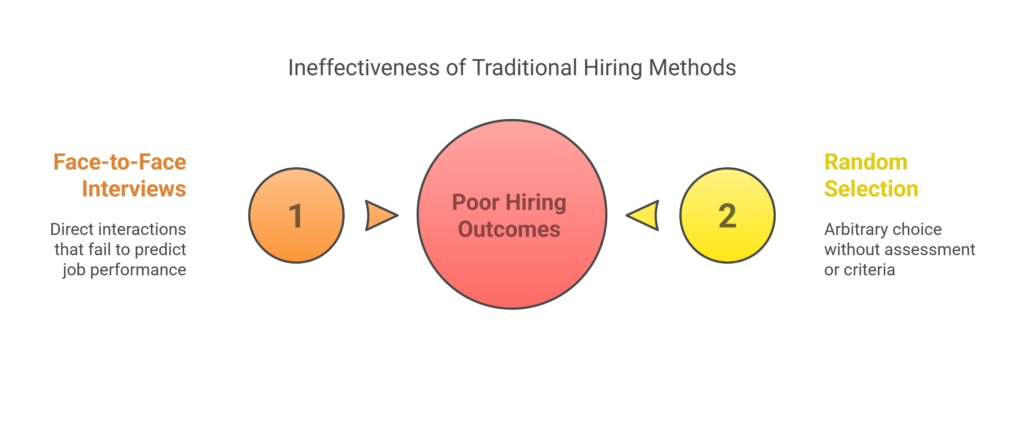
Conclusion: Stop Gambling on Interviews – Start Hiring Smarter
In today’s fast-paced business environment, talent is often the differentiator between companies that thrive and those that struggle. Hiring shouldn’t be a game of chance, yet for too long the standard interview process has been exactly that – a gamble with roughly 50/50 odds. We now have the research and tools to do better. By recognizing that unstructured interviews are no better than random chance, forward-thinking companies can break from tradition and embrace a more scientific approach to hiring.
Start by injecting structure and objectivity into your interviews, and complement them with proven assessments. Treat hiring as a high-stakes decision that warrants the same rigor as any other business-critical process. When you do, you’ll see the payoff: more confident hires, higher employee success rates, and fewer costly mistakes. As a business leader, there are few levers that can impact your bottom line as directly as improving your hiring accuracy.
The actionable steps are in front of you – and you don’t have to do it all alone. Implement what you can, and don’t hesitate to lean on experts for the rest. Whether that means using hiring software, consulting with industrial-organizational psychologists, or partnering with an agency like Divino Business Solutions, what matters is that you take your hiring practices from guesswork to best practices. In the end, the goal is simple: to hire smarter, so your company can execute smarter. With a bit of effort now to fix your hiring process, you can stop rolling the dice on interviews and start building the talented team your business needs to succeed.
References (Studies & Articles Cited):
✅ Frequently Asked Questions (FAQs)
1. Why are traditional interviews so unreliable when hiring talent?
Unstructured interviews often feel natural—but they’re notoriously poor predictors of actual job performance. Studies show that decisions made in traditional interviews are often based on gut feelings, appearance, or personality traits rather than skills and fit. This means companies could be missing out on the best candidates. If you’re serious about hiring smarter in Canada or the USA, consider implementing structured assessments and standardized processes.
2. What is a structured interview, and how does it help reduce hiring bias?
A structured interview is one where each candidate is asked the same job-relevant questions, scored using a consistent rubric. Unlike casual conversations, structured interviews reduce personal bias and ensure fairness across the board. They’re backed by decades of research and are proven to be significantly more reliable in predicting performance. If you’re asking, how can I hire talent near me without bias? — this is the place to start.
3. Is hiring based on testing really better than interviews?
Yes—when done right. Skills-based tests, personality assessments, and work samples are much more predictive of job success than interviews alone. Cognitive testing and work simulations allow you to evaluate talent objectively, which lowers your risk of bad hires. Google, Amazon, and many high-performance companies already use this approach. The key is to use validated assessments tailored to your role.
4. What alternatives do small businesses have to traditional interviews?
Small businesses often don’t have in-house HR analytics or time to develop detailed hiring tests. That’s why many Canadian and American companies partner with recruitment firms like Divino Business Solutions, who already have structured systems in place. From candidate screening to behavioral assessments, they handle the heavy lifting so you can hire top talent without guessing.
5. How can I improve my company’s hiring strategy today?
Start by reviewing your current interview process. Are your questions consistent? Are you testing skills or just personalities? Then, consider adding structured interviews, work samples, and cognitive assessments to your pipeline. If that sounds overwhelming, don’t worry—Divino Business Solutions specializes in science-backed recruitment that takes care of this for you. They’ve helped companies across Canada and the US hire smarter—without the stress.
Need help improving your hiring process? Contact Divino Solutions today for science-backed recruitment solutions or check out how to simplify recruitment or The Bias of Interviews: Are You Just Hiring a Smile?
- Sunwall, E. (2022). Hiring Interviews Are Terrible: Smart UX Teams Structure Them. Nielsen Norman Group. (Hiring Interviews Are Terrible: Smart UX Teams Structure Them – NN/g)
- Sullivan, J. (2019). Hiring Interviews Have Lost Their Accuracy — A Warning. DrJohnSullivan.com / ERE.net. (Hiring Interviews Have Lost Their Accuracy — A Warning – Dr John Sullivan)
- Schmidt, F. & Hunter, J. (1998). The validity and utility of selection methods in personnel psychology. Psychological Bulletin, 124(2), 262–274. (Summary of findings cited in Sullivan, 2019) (Hiring Interviews Have Lost Their Accuracy — A Warning | ERE)
- Sackett, P. et al. (2021). Revisiting meta-analytic estimates of validity in personnel selection. Journal of Applied Psychology. (Findings discussed via Sunwall, 2022) (Hiring Interviews Are Terrible: Smart UX Teams Structure Them – NN/g)
- Psychology Today (2020). Poor Predictors: Job Interviews Are Useless and Unfair. (Poor Predictors: Job Interviews Are Useless and Unfair | Psychology Today) (Referenced Jason Dana’s research and Texas medical school example)
- Dana, J. (2017). The Utter Uselessness of Job Interviews. New York Times (Op-Ed). (Med school admissions study and random-answer experiment) (Poor Predictors: Job Interviews Are Useless and Unfair | Psychology Today)
- Nielsen, N. (2018). Why We Lie in Job Interviews. Harvard Business Review. (Not directly cited above, but provides statistic on prevalence of lying) (Poor Predictors: Job Interviews Are Useless and Unfair | Psychology Today)
- McKinsey & Company (2020). Diversity Wins: How Inclusion Matters. (Report finding 36% profitability boost for diverse companies) (Hiring Interviews Are Terrible: Smart UX Teams Structure Them – NN/g)
- Levashina, J. et al. (2014). The Structured Employment Interview: Narrative and Quantitative Review. Personnel Psychology, 67(1), 241–293. (Comprehensive review supporting structured interviews) (Hiring Interviews Are Terrible: Smart UX Teams Structure Them – NN/g)
- Huffcutt, A. & Arthur, W. (1994). Hunter and Hunter (1984) Revisited: Interview validity for entry-level jobs. Journal of Applied Psychology, 79(2), 184–190. (Early meta-analysis showing higher validity with structure) (Hiring Interviews Are Terrible: Smart UX Teams Structure Them – NN/g)

